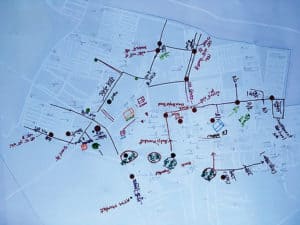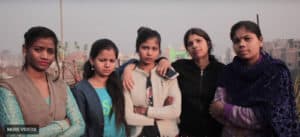From rapping to maintaining WhatsApp diaries, these girls from Madanpur Khadar colony are putting across their day-to-day challenges in digital format
“Mere sath kaho ekbar
Yeh sheher humara aap ka,
Nahi kisi ke baap ka”
(This city is for you and me, this city is no one’s property)
This is the voice of the street. In Madanpur Khadar JJ colony, a group of 11 girls from the slum resettlement colony in south east Delhi have found a unique way to convey their daily ordeals – through rap.
Titled ‘Khadar ki ladkiyan’, the music video has garnered quite a few views on YouTube. Confident and unrestrained, these girls attack the accepted misogynistic norms of the society through lyrics that narrate the problems and harassment they face, both at home and on the streets.
Ranging from unmarried, divorced, single mothers, to young girls working and studying alongside — the girls are a mixed batch.
Largely shot in the narrow public lanes and open markets — spaces that are dominated by men, these girls brush aside the male gaze and boldly go ahead with the filming, pumping their fists in the air.
Penning down their own stories along with their observations from the news and their neighbourhood, the lyrics detail their fears and experiences. From sexual harassment, violence in public spaces, absence of streets lights, to questioning the role of police, the song has addressed it all.
‘Why has society suppressed us instead of ironing out its own faults? Why am I the one facing house arrest?’, goes one of the lines in the song. Wearing purple t-shirts with ‘Khadar ki ladkiyan’ written at the back, they tackle patriarchy head on.
Choosing hip-hop as the rhythm and style for the song, Sunayana Wadhawan, sound artist and music director, explains in her blog, “Discussing the history of hip-hop as a medium of protest and expression, we watched videos and grooved to different songs to become more familiar with the sound and delivery of messages through spoken word. Apart from clapping and dancing, one of the exercises I conducted was an attempt to find a shared rhythm using a timing that we are all familiar with – the sounds made when we wash clothes. It was an extraordinary moment as all the women were well versed with the actions and sounds involved in washing clothes – a domestic chore often delegated to women in the house.”

The video is a part of a bigger project titled ‘Aana Jaana’, which aims at understanding the violence faced by women while navigating public spaces in a digital age and to make the city more gender inclusive. It presents how women from the resettlement colonies, urban villages and border towns of the city view and understand the city through their mobile phones. Funded by Arts and Humanities Research Council UK network under ‘Gendering the smart city, it is co-organised by King’s Colleg,e London, Safetipin, non-profit Jagori and School of Planning and Architecture.
“It shows us how women living on the urban peripheries negotiate the ‘freedoms’ of moving (aana) in online space with the ‘dangers’ of going out (jaana) into the city” reads a note on the exhibition.
“The project brings out a paradox in the notion of inclusion and exclusion. While these girls enjoy the freedom to digitally navigate in the city, they are completely excluded from basic infrastructure like water, sewage, sanitation, electricity. At the same time, the promise of digital technologies also remains unfulfilled with slow data speed, dropped calls, older models of mobile phones which slow down app interfaces,” says Ayona Datta, project head of Gendering the Smart City.
Curating women’s everyday stories of coming and going in the city through participatory maps, photographs, videos and WhatsApp diaries maintained by these women over a period of six months, a photo exhibition at Mandi House metro station brings it all together.
Daily diaries
WhatsApp turned out to be more than just a mode of communication for this project. The girls started to share their daily experiences — almost like a journal, in a closed WhatsApp group with the 11 girls and admin as members.
From the obstacles and dilemmas they faced while commuting, to the small moments of pleasant surprises, they shared everything on the group. Using regular text, images, audio and video messages, they documented and voiced their struggles with almost daily entrees in the group.
Recounting the daily harrassment they face, one of the Whatspp entries reads, “When we come in a dark lane in the neighbourhood, a lot of vehicles pass by us. They comment things like, “Will you go with me”, “Come! I’ll drop you off”, “Kya cheez hai, you look very beautiful”. There are no police or lights in that area, it is very deserted. Finally, when you reach the market, you can see the lights and people passing, but nobody cares for anyone, nobody would even ask the men “Why did you say this?”

Not limiting themselves to just insecurities they face regularly, they also critique the absence of basic infrastructure in the city through texts accompanied by photos to substantiate it. Water logging in the locality during rains, traffic jams, lack of affordable public transport, the groups got flooded with daily inputs from the girls.
“In today’s morning rains, the roads got filled with so much water that it was difficult for people to get out, the water from the drains were also overflowing, and people were forced to wade through it,” read one of the messages along with images.
It’s not all restricted to their plights, as the girls share positive stories as well. “I’m sitting on a rickshaw for Okhla phase 2, and the driver is a woman! It makes me really happy, and she’s riding it very calmly,” states another entry in the group.
Participatory map
Another key aspect of the project was the safety mapping of the area created by the girls themselves with Safetipin, a map-based mobile phone application. Sketched by the girls themselves, they use colourful bindis to mark out the places that are safe and unsafe according to them. The safety audit of Madanpur Khadar received a score of 2.8 out of 5.
The map along with photo essays that capture the struggles of the daily lives of women in the colony attempts to highlight the issue of safety of women beyond just data numbers and giving them a chance to voice their problems in a digital space.
The exhibition is on at Mandi House Metro Station till January 31





